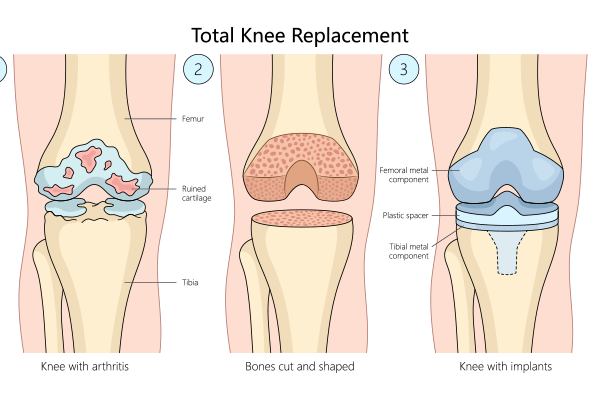
Knee replacement surgery is a common procedure aimed at relieving pain and restoring function in severely diseased knee joints. There are two primary types of knee replacement surgeries: partial knee replacement surgery and total knee replacement. Understanding the differences between these two types can help patients make informed decisions about their treatment options.
Synopsis
What is Knee Replacement Surgery?
Knee replacement surgery, also called knee arthroplasty, involves taking out the damaged parts of the knee joint and replacing them with artificial parts. This surgery is usually recommended for people with severe arthritis or major knee injuries that don't get better with other treatments.

Partial Knee Replacement
Definition
Partial knee replacement, also known as unicompartmental knee replacement, involves replacing only the damaged part of the knee joint. This procedure is suitable for patients with damage confined to a single compartment of the knee, usually due to osteoarthritis.
Procedure
During a half-knee replacement procedure, the surgeon makes a small incision and removes the damaged cartilage and bone from the affected compartment. The remaining healthy cartilage and bone are preserved. The surgeon then implants a metal and plastic prosthesis to replace the damaged area.
Advantages
-
Less Invasive: Half knee replacement is less invasive than total knee replacement, resulting in smaller incisions and less tissue damage.
-
Faster Recovery: Patients typically experience a quicker recovery and shorter hospital stay.
-
Natural Knee Movement: Since only a part of the knee is replaced, patients often retain more natural knee movement and function.
-
Lower Risk of Complications: There is a reduced risk of complications such as blood clots and infections.
Disadvantages
-
Limited to Specific Cases: Not all patients are candidates for partial knee replacement. It is only suitable for those with damage confined to one compartment.
-
Potential for Further Surgery: Patients may require additional surgery in the future if arthritis progresses to other parts of the knee.
Total Knee Replacement
Definition
Total knee replacement, also known as total knee arthroplasty, involves replacing the entire knee joint. This procedure is recommended for patients with widespread arthritis or severe knee damage affecting multiple compartments of the knee.
Procedure
In a total knee replacement, the surgeon makes a larger incision to access the entire knee joint. The damaged cartilage and bone are removed from the femur, tibia, and patella. The surgeon then implants metal and plastic components to replace the entire knee joint.
Advantages
-
Comprehensive Solution: Total knee replacement addresses all damaged areas of the knee, providing a comprehensive solution for severe arthritis.
-
Long-Lasting Results: The prosthetic components used in total knee replacement are designed to last for many years, offering long-term relief from pain and improved function.
-
High Success Rate: Total knee replacement has a high success rate, with most patients experiencing significant pain relief and improved quality of life.
Disadvantages
-
More Invasive: Total knee replacement is a more invasive procedure, resulting in larger incisions and more tissue damage.
-
Longer Recovery: Patients typically require a longer recovery period and may need extensive physical therapy.
-
Higher Risk of Complications: There is a higher risk of complications such as blood clots, infections, and implant loosening.
Comparing Partial and Total Knee Replacement
Indications
-
Partial Knee Replacement: Suitable for patients with localized damage to one compartment of the knee.
-
Total Knee Replacement: Recommended for patients with widespread arthritis or severe damage affecting multiple compartments.
Recovery Time
-
Partial Knee Replacement: Faster recovery, shorter hospital stay, and quicker return to normal activities.
-
Total Knee Replacement: Longer recovery period, extended hospital stay, and more intensive rehabilitation.
Longevity
-
Partial Knee Replacement: May require additional surgery if arthritis progresses.
-
Total Knee Replacement: Designed to provide long-lasting results, often lasting 25-30 years or more.
Risks and Complications
-
Partial Knee Replacement: Lower risk of complications, but limited to specific cases.
-
Total Knee Replacement: moderate risk of complications, but suitable for a broader range of patients.
|
Factor |
Partial Knee Replacement |
Total Knee Replacement |
|
Procedure |
Small incision, less invasive |
Larger incision, more invasive |
|
Recovery Time |
Faster recovery, shorter hospital stay |
Longer recovery, extended hospital stay |
|
Natural Knee Movement |
Retains more natural knee movement |
Less natural movement due to complete joint replacement |
|
Suitability |
Suitable for localized damage to one compartment |
Suitable for widespread arthritis or severe damage |
|
Longevity |
May require additional surgery if arthritis progresses |
Designed to last 25-30 years or more |
|
Risk of Complications |
Lower risk of complications |
Higher risk of complications |
|
Advantages |
Less invasive, faster recovery, lower risk of complications |
Comprehensive solution, long-lasting results, high success rate |
|
Disadvantages |
Limited to specific cases, the potential for further surgery |
More invasive, longer recovery, higher risk of complications |
This table provides a clear comparison of the key aspects of partial and total knee replacement surgeries, helping patients understand the differences and make informed decisions.
Conclusion
Choosing between partial and total knee replacement depends on the extent of knee damage, the patient's overall health, and their lifestyle needs. Both procedures offer significant benefits, but they also come with their own set of risks and considerations. Consulting with an orthopaedic surgeon can help patients determine the most appropriate treatment option for their specific condition.
Knee replacement surgery, whether partial or total, can significantly improve the quality of life for patients suffering from severe knee pain and dysfunction. By understanding the differences between these two types of surgeries, patients can make informed decisions and take the first step towards a pain-free and active life.
FAQ's
The surgery usually takes about 1 to 2 hours, but the total time at the hospital may be longer due to pre- and post-operative care.
Knee replacement surgery, also known as knee arthroplasty, involves replacing damaged parts of the knee joint with artificial implants to relieve pain and improve function.
Recovery can take up to 3 months, with most patients resuming normal activities within 6 weeks. Full recovery may take up to a year.
Knee implants typically last 25-30 years, but this can vary based on activity level and overall health.
Non-dairy sources of calcium include leafy greens, almonds, fortified plant milk, tofu, and certain fish like salmon and sardines. It's important to ensure adequate intake of calcium and vitamin D for bone health.
Yes, physical therapy is crucial for recovery, helping to restore movement and strength in the knee





















 5 Min Read
5 Min Read
















